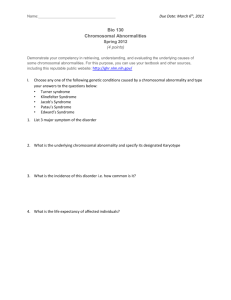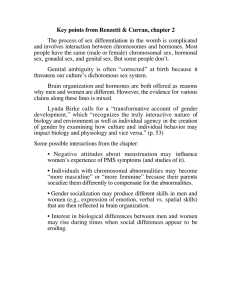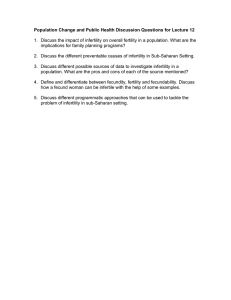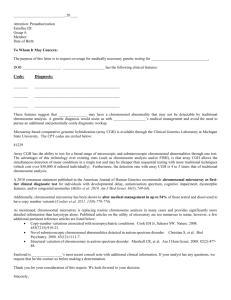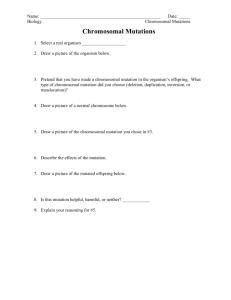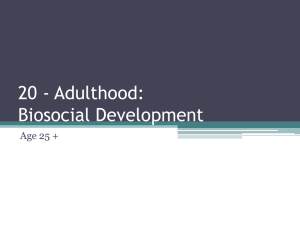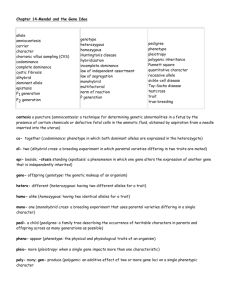Document 13310396
advertisement
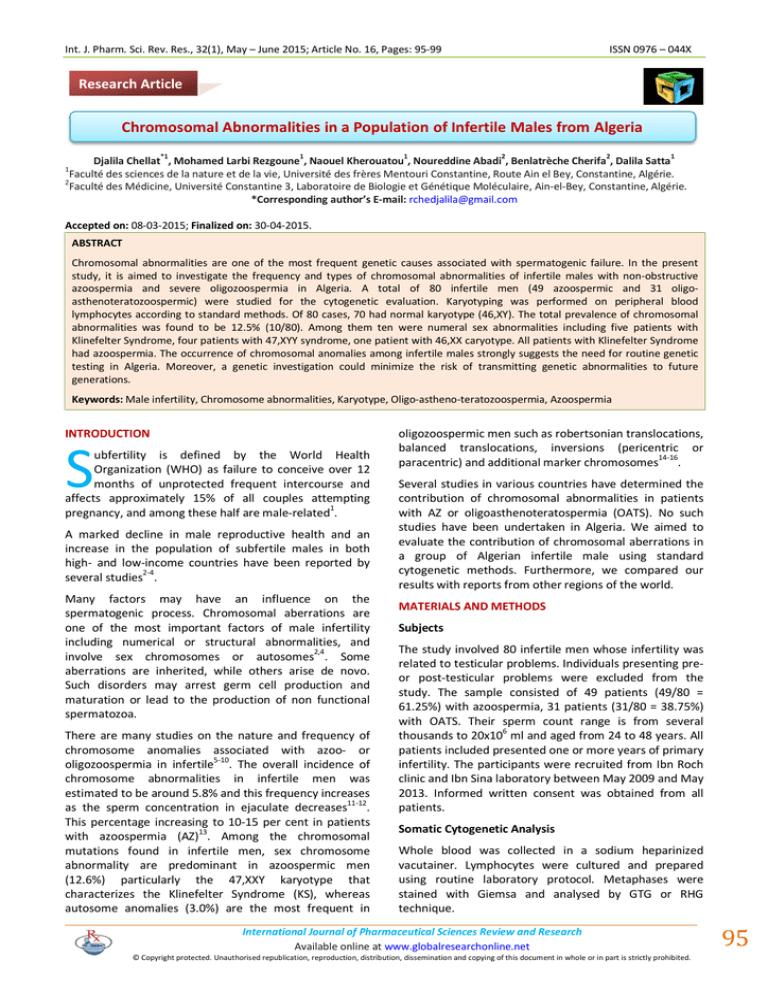
Int. J. Pharm. Sci. Rev. Res., 32(1), May – June 2015; Article No. 16, Pages: 95-99 ISSN 0976 – 044X Research Article Chromosomal Abnormalities in a Population of Infertile Males from Algeria *1 1 1 2 2 1 Djalila Chellat , Mohamed Larbi Rezgoune , Naouel Kherouatou , Noureddine Abadi , Benlatrèche Cherifa , Dalila Satta Faculté des sciences de la nature et de la vie, Université des frères Mentouri Constantine, Route Ain el Bey, Constantine, Algérie. 2 Faculté des Médicine, Université Constantine 3, Laboratoire de Biologie et Génétique Moléculaire, Ain-el-Bey, Constantine, Algérie. *Corresponding author’s E-mail: rchedjalila@gmail.com 1 Accepted on: 08-03-2015; Finalized on: 30-04-2015. ABSTRACT Chromosomal abnormalities are one of the most frequent genetic causes associated with spermatogenic failure. In the present study, it is aimed to investigate the frequency and types of chromosomal abnormalities of infertile males with non-obstructive azoospermia and severe oligozoospermia in Algeria. A total of 80 infertile men (49 azoospermic and 31 oligoasthenoteratozoospermic) were studied for the cytogenetic evaluation. Karyotyping was performed on peripheral blood lymphocytes according to standard methods. Of 80 cases, 70 had normal karyotype (46,XY). The total prevalence of chromosomal abnormalities was found to be 12.5% (10/80). Among them ten were numeral sex abnormalities including five patients with Klinefelter Syndrome, four patients with 47,XYY syndrome, one patient with 46,XX caryotype. All patients with Klinefelter Syndrome had azoospermia. The occurrence of chromosomal anomalies among infertile males strongly suggests the need for routine genetic testing in Algeria. Moreover, a genetic investigation could minimize the risk of transmitting genetic abnormalities to future generations. Keywords: Male infertility, Chromosome abnormalities, Karyotype, Oligo-astheno-teratozoospermia, Azoospermia INTRODUCTION S ubfertility is defined by the World Health Organization (WHO) as failure to conceive over 12 months of unprotected frequent intercourse and affects approximately 15% of all couples attempting pregnancy, and among these half are male-related1. A marked decline in male reproductive health and an increase in the population of subfertile males in both high- and low-income countries have been reported by several studies2-4. Many factors may have an influence on the spermatogenic process. Chromosomal aberrations are one of the most important factors of male infertility including numerical or structural abnormalities, and involve sex chromosomes or autosomes2,4. Some aberrations are inherited, while others arise de novo. Such disorders may arrest germ cell production and maturation or lead to the production of non functional spermatozoa. There are many studies on the nature and frequency of chromosome anomalies associated with azoo- or 5-10 oligozoospermia in infertile . The overall incidence of chromosome abnormalities in infertile men was estimated to be around 5.8% and this frequency increases as the sperm concentration in ejaculate decreases11-12. This percentage increasing to 10-15 per cent in patients with azoospermia (AZ)13. Among the chromosomal mutations found in infertile men, sex chromosome abnormality are predominant in azoospermic men (12.6%) particularly the 47,XXY karyotype that characterizes the Klinefelter Syndrome (KS), whereas autosome anomalies (3.0%) are the most frequent in oligozoospermic men such as robertsonian translocations, balanced translocations, inversions (pericentric or paracentric) and additional marker chromosomes14-16. Several studies in various countries have determined the contribution of chromosomal abnormalities in patients with AZ or oligoasthenoteratospermia (OATS). No such studies have been undertaken in Algeria. We aimed to evaluate the contribution of chromosomal aberrations in a group of Algerian infertile male using standard cytogenetic methods. Furthermore, we compared our results with reports from other regions of the world. MATERIALS AND METHODS Subjects The study involved 80 infertile men whose infertility was related to testicular problems. Individuals presenting preor post-testicular problems were excluded from the study. The sample consisted of 49 patients (49/80 = 61.25%) with azoospermia, 31 patients (31/80 = 38.75%) with OATS. Their sperm count range is from several 6 thousands to 20x10 ml and aged from 24 to 48 years. All patients included presented one or more years of primary infertility. The participants were recruited from Ibn Roch clinic and Ibn Sina laboratory between May 2009 and May 2013. Informed written consent was obtained from all patients. Somatic Cytogenetic Analysis Whole blood was collected in a sodium heparinized vacutainer. Lymphocytes were cultured and prepared using routine laboratory protocol. Metaphases were stained with Giemsa and analysed by GTG or RHG technique. International Journal of Pharmaceutical Sciences Review and Research Available online at www.globalresearchonline.net © Copyright protected. Unauthorised republication, reproduction, distribution, dissemination and copying of this document in whole or in part is strictly prohibited. 95 © Copyright pro Int. J. Pharm. Sci. Rev. Res., 32(1), May – June 2015; Article No. 16, Pages: 95-99 A minimum of 20 metaphases were analyzed for each patient, but if mosaicism was suspected then 50 or more cell counts were undertaken. Karyotypes were described according to the International System for Human 17 Cytogenetic Nomenclature . RESULTS Karyotyping was carried out in 80 infertile men with idiopathic AZ (n=49) or OATS (n=31). Genetic abnormalities were found in 12.5% of all infertile men studied (Table 1). As shown in Table 1, of these patients, a total of 10 patients (1 with OATS and 9 azoospermic patients) had chromosomal abnormalities, including 5 patients with KS (47,XXY), 4 patients with 47,XYY syndrome, one patient was diagnosed as a 46,XX male. Considering only the patients with OATS, the frequency of chromosomal abnormalities was 3.22% (1/31), while in those with AZ it was 18.37% (9/49). The commonest chromosomal anomaly was 47,XXY (KS); three cases were pure types and two were mosaics. AZ was found in all these patients. The second frequent sex chromosome anomaly was 47,XYY seen in four patient (4/11). 3 of these patients have azoospermia and one with OATS (Table 2). The case of 46,XX male syndrome had an atrophic testicles. DISCUSSION Among the numerous etiologic factors of male infertility, chromosomal abberations play an important role. The exact mechanism by which these anomalies induce infertility is not clear. It was suggested that pairing anomalies within the sex chromosomes are implicated in the disruption of spermatogenesis with meiotic arrest, and subsequent oligozoospermia or azoospermia18. The frequency of chromosomal abnormalities found in the several studies varies depending on a number of factors; the most important of these is the criteria for selection of patients based on the sperm counts and ranges from 7.319 to 14%20. In the present study, the rate of chromosomal anomalies observed among infertile men (<20 million/ml) was 12.5%. The highest frequency of abnormal karyotype 11.25% (9/80) was found among patients with AZ. This figure is comparable to that reported in some studies5,6,21-25, but higher26-31 or lower9,32-36 than reported from others published data. In the literature, the frequency of chromosomal anomalies are 14.2% in males with azoospermia and 6.5 % in men with oligozoospermia is within the range of 1015 and 5-7 % respectively13,37. Our results (11.25% for azoospermia and 1.25% for OATS) were consistent with these previous reports. Among the chromosomal abnormalities found, the most common chromosomal aberration was KS. This anomaly represents the most common genetic cause of human male infertility with a prevalence of 1 in 66038. In the ISSN 0976 – 044X current study, KS was present in 50% (5/11) of all chromosomal abnormalities. This is in accordance with previously published studies. For example, in Carrara report, the 47,XXY karyotype was the most frequent 27 chromosomal alteration . Also, Ferlin reported that the prevalence of KS among infertile men is very high, up to 5% in severe oligozoospermia and 10% in azoospermia15. Mahjoubi have also reported that the most prevalent chromosomal abnormality in the infertile men was 7 47,XXY, which was detected in 94 (58.38%) men . In addition, in the study of Zhang the KS was the most common anomaly occurring in 82.41% of all patients36. The majority of KS patients have a homogeneous XXY karyotype but approximately 15–20% of them are mosaics with variable phenotypes32,39. In this study, a mosaic 46,XY/47,XXY karyotype was found in two azoospermic men. Ghorbel found that three of the ten 9 patients with KS had mosaic form . Some men with mosaicism have normal testicular size and spermatogenesis at puberty, but germ cells are progressively lost overtime40,41. As we know in general, male with KS have infertility. In a very small number of cases, males with 47,XXY have been able to produce children through assisted reproductive techniques39. The XYY syndrome is characterized by an extra copy of the Y chromosome, with an incidence of 1 in 1000 males42. Four patient with 47,XYY were found in our studied group (5%). This anomaly have been also found in many reports5,22,34,43. The 46,XX males represents the most common condition in which testicular development occurs in the absence of a Y chromosome. This disorder occurs at a frequency of 1/25.000 newborns42. In our study population, there was one patient who presented a 46,XX karyotype actually known as 46,XX testicular disorder of sex development (DSD). Ghorbel have reported two men with 46,XX karyotype9. Another cytogenetic study enrolled by Akin revealed one patient with 46,XX DSD8. A review by Hofherr is based on larger numbers of patients. In total, data from 2,242 men have been evaluated, a frequency of 14.3% of abnormal 22 karyotypes including 7 46,XX males . Phenotypically the adults are similar to patients with KS. Three groups have traditionally been described, based on phenotype: males with normal male phenotype, males with ambiguous genitalia, and true hermaphrodites44-45. Several etiologies have been proposed and subsequently observed, on the basis of a genetic heterogeneity, to explain 46,XX male: (i) translocation of the testisdetermining factor (TDF), equated more recently with the sex-determining region Y gene (SRY), from the Y to the distal short arm of the X chromosome during male meiosis; (ii) mutation in an autosomal or X chromosome gene which permits testicular determination in the 14 absence of TDF . International Journal of Pharmaceutical Sciences Review and Research Available online at www.globalresearchonline.net © Copyright protected. Unauthorised republication, reproduction, distribution, dissemination and copying of this document in whole or in part is strictly prohibited. 96 © Copyright pro Int. J. Pharm. Sci. Rev. Res., 32(1), May – June 2015; Article No. 16, Pages: 95-99 In conclusion, this work describes one of the largest studies of male infertility and includes the first results of cytogenetic analysis of 80 Algerian infertile males. ISSN 0976 – 044X Acknowledgement: We wish to thank all members of Biology and Genetics Laboratory, the PMA IbnRochd Centre and private laboratories of Algeria for their contributions to this work. We wish also to thank all patients for their cooperation in the present study. When comparing this study to prior reports, the frequencies of abnormalities are similar. This incidence was high in our samples. We conclude that all patients with non obstructive azoospermia and OATS should be referred for cytogenetic investigation. Table 1: Different types of chromosomal aberrations encountered in 10 of 80 infertile men Spermparameters Chromosomal aberrations Karyotype Female Karyotype 46,XX Number of patients Hormonal analysis Sperm Count (million/ml) Motility % Morphology % FSHmU/ml LH mU/ml TEST ng/ml 0 0 0 0.9 0.38 10.6 18.81 NA 16.56 0.28 NA 1.37 1 47,XXY 1 2 3 Numerical 5 47,XXY / 46,XY 1. 2. 47,XYY 1. 2. 3. 4. 4 0 0 0 24.34 NA 27.5 0 0 0 0 0 0 NA 12.74 NA 5.5 NA 1.5 0 3.1 0 0 0 4 0 0 0 14 0 0 NA 8.48 35.1 NA NA 5.48 4.01 NA NA 1.1 4.34 NA NA: not available Table 2: Sex chromosomal abnormalities in a sample of infertile men with AZ or OATS Chromosomal Abnormalities Sperm Disorder Total % of Total 30 70 87.5 Azoospermia OATS 46,XY (normal) 40 47,XXY 3 - 3 3.75 47,XXY / 46,XY 2 - 2 2.5 47,XYY 3 1 4 5 46,XX 1 - 1 1.25 Total 49 31 80 100 AZ: azoospermia; OATS: oligoasthenoteratozoospermia deletions. State of the art 2004. Int J Androl. 27, 2004, 240– 249. REFERENCES 1. Skakkebaek NE, Giwercman A, de Kretser D. Pathogenesis and management of male infertility. Lancet. 343, 1994, 1473-1479. 2. de Kretser DM. Male infertility. Lancet. 349, 1997, 787– 790. 3. Dohle GR, Halley DJ. Genetic risk factors in infertile men with severe oligozoospermia and azoospermia. Hum Reprod. 17, 2002, 13–16. 4. Simoni M, Bakker E, Krausz C. EAA/EMQN best practice guidelines for molecular diagnosis of Y chromosomal micro 5. Nagvenkar P, Desai K, Hinduja I, Zaveri K. Chromosomal studies in infertile men with oligozoospermia & nonobstructive azoospermia. Indian J Med Res. 122, 2005, 3442. 6. Balkan M, Tekes S, Gedik A. Cytogenetic and Y chromosome micro deletion screening studies in infertile males with Oligozoospermia and Azoospermia in Southeast Turkey. J Assist Reprod Genet. 25, 2008, 559–565. 7. Mahjoubi F, Soleimani S, Mantegy S. Chromosomal Abnormalities in Infertile Men Referred to Iran Blood International Journal of Pharmaceutical Sciences Review and Research Available online at www.globalresearchonline.net © Copyright protected. Unauthorised republication, reproduction, distribution, dissemination and copying of this document in whole or in part is strictly prohibited. 97 © Copyright pro Int. J. Pharm. Sci. Rev. Res., 32(1), May – June 2015; Article No. 16, Pages: 95-99 ISSN 0976 – 044X Transfusion Organization Research Center. J Reprod Infertil. 11, 2010, 175-178. causes of male infertility: the Mayo Clinic experience. J AssistReprod Genet. 28, 2011, 1091-1098. 8. Akin H, Onay H, Turker E, Ozkinay F. Primary male infertility in Izmir/Turkey: acytogenetic and molecular study of 187 infertile Turkish patients. J Assist Reprod Genet. 28, 2011, 419-423. 23. Al-achkar W, Wafa A and Moassass F. Cytogenetic abnormalities and Y-chromosome micro deletions in infertile Syrian males. Biomedical Reports. 1, 2013, 275279. 9. Ghorbel M, Gargouri Baklouti S, Ben Abdallah F, Zribi N, Cherif M, Keskes R, Chakroun N, Sellami A, Belguith N, Kamoun H, Fakhfakh F, Ammar-Keskes L. Chromosomal defects in infertile men with poor semen quality. J AssistReprod Genet. 29, 2012, 451–456. 24. Elfateh F, Wang R, Zhang Z, Jiang Y, Chen S, Liu R. Influence of genetic abnormalities on semen quality and male fertility: A four-year prospective study. Iran J Reprod Med. 12, 2014, 95-102. 10. Han TT, Ran J, Ding XP, Li LJ, Zhang LY, Zhang YP, Nie SS, Chen L. Cytogenetic and molecular analysis of infertile Chinese men: karyo typical abnormalities, Y-chromosome micro deletions, and CAG and GGN repeat polymorphisms in the androgen receptor gene. Genet Mol Res. 8(12), 2013, 2215-2226. 11. Chandley AC, Edmond P, Christie S, Gowans L, Fletcher J, Frackiewicz A, Newton M. Cytogenetics and infertility in man. I. Karyotype and seminal analysis. Annals of Human Genetics. 39, 1975, 231-254. 12. Valetto A, Bertini V, Rapalini E, Baldinotti F, Di Martino D, Simi P. Molecular and cytogenetic characterization of a structural rearrangement of the Y chromosome in an azoospermic man. FertilSteril. 81, 2004, 1388-1390. 13. Retief AE, Van Zyl JA, Menkveld R, Fox MR, Kotze GM, Brusnicky J. Chromosome studies in 496 infertile males with a sperm count below 10 million/ml. Hum Genet. 66, 1984, 162-164. 14. Van Assche E, Bonduelle M, Tournaye H, Joris H, Verheyen G, Devroey P, Van Steirteghem A, Liebaers I. Cytogenetics of infertile men. Hum Reprod. 11(1-24), 1996, discussion 25-6. 15. Ferlin A, Arredi B, Foresta C. Genetic causes of male infertility. ReprodToxicol. 22, 2006, 133-141. 16. Zhou-Cun A, Yuan Y, Si-Zhong Z, Wei Z, Li L. Chromosomal abnormality and Y chromosome micro deletion in Chinese patients with azoospermia or severe oligozoospermia. Acta GeneticaSinica. 33, 2006, 111-116. 17. Shaffer LG, Slovak ML, Campbell LJ (eds), ISCN (2009): An International System for human Cytogenetic Nomenclature, Basel, Karger, 2009. 18. Egozcue J, Templado C, Vidal F, Navarro J, Morer-Fargas F, Marina S. Meiotic studies in a series of 1100 infertile and sterile males. Hum Genet. 65, 1983, 185-188. 19. Micic M, Micic S, Dirlik V. Chromosomal Constitution of Infertile Men. Clin Genet. 25, 1984, 33-36. 20. Hendry WF, Polani PE, Pugh RC, Sommerville IF, Wallace DM. 200 Infertile males: correlation of chromosome, histological, endocrine and clinical studies. Br J Urol. 47, 1975, 899-908. 21. Kalantari P, Sepehri H, Behjati F, Ousati Ashtiani Z, Akbari MT. Chromosomal Studies in Infertile Men. Russian Journal of Genetics. 39, 2003, 423–426. 22. Hofherr SE, Wiktor AE, Kipp BR, Dawson DB, Van Dyke DL. Clinical diagnostic testing for the cytogenetic and molecular 25. Mierla D, Jardan D, Stoian V. Chromosomal abnormality in men with impaired spermatogenesis. Int J FertilSteril. 8, 2014, 35-42. 26. Van der Ven K, Montag M, Peschka B, Leygraaf J, Schwanitz G, Haidl G, Krebs D, Van der Ven H. Combined cytogenetic and Y chromosome micro deletion screening in males undergoing intracytoplasmic sperm injection. Molecular Human Reproduction. 3, 1997, 699–704. 27. Carrara RCV, Yamasaki R, Mazucatto LF, Veludo MAL, Sartorato EL, Pina-Neto JM. Somatic and germ cell cytogenetic studies and AZF micro deletion screening in infertile men. Genet Mol Biol. 27, 2004, 477-482. 28. Pina-Neto JM, Carrara RC, Bisinella R, Mazzucatto LF, Martins MD, Sartoratto E, Yamasaki R. Somatic cytogenetic and azoospermia factor gene micro deletion studies in infertile men. Braz J Med BiolRes. 39, 2006, 555-561. 29. Wang Y, Han W, Guan C, Wang G, Zhu X, Jiang M, Bian C, Li J, Yang Z. Cytogenetic study on couples with a history of reproductive failure in china. Journal of Reproduction & Contraception. 20, 2009, 237-246. 30. Koşar PA, Ozçelik N, Koşar A. Cytogenetic abnormalities detected in patients with non-obstructive azoospermia and severe oligozoospermia. J AssistReprod Genet. 27, 2010, 17–21. 31. Rosenbusch B. Somatic chromosomal abnormalities in couples undergoing infertility treatment by intracytoplasmic sperm injection. Journal of Genetics. 89, 2010, 105-108. 32. Bouayed-Abdelmoula N, Amouri Ah, Portnoi M-F, Saad A, Boudawara T, Mhiri MN, Bahloul A, Rebai T. Cytogenetics and fluorescence in situ hybridization assessment of sexchromosome mosaicism in Klinefelter’s syndrome. Ann Genet. 47, 2004, 163-175. 33. Dada R, Gupta NP, Kucheria K. Cytogenetic and Molecular Analysis of Male Infertility. Cell Biochem Biophys. 44, 2006, 171-177. 34. Ng PP, Tang MH, Lau ET, Ng LK, Ng EH, Tam PC, Yeung WS, Ho PC. Chromosomal anomalies and Y-micro deletions among Chinese subfertile men in Hong Kong. Hong Kong Med J. 15, 2009, 31-38. 35. Mafra FA, Christofolini DM, Bianco B, Gava MM, Glina S, Belangero SI, Barbosa CP. Chromosomal and Molecular Abnormalities in a Group of Brazilian Infertile Men with Severe Oligozoospermia or Non-Obstructive Azoospermia Attending an Infertility Service.Int Braz J Urol. 37, 2011, 244-250. International Journal of Pharmaceutical Sciences Review and Research Available online at www.globalresearchonline.net © Copyright protected. Unauthorised republication, reproduction, distribution, dissemination and copying of this document in whole or in part is strictly prohibited. 98 © Copyright pro Int. J. Pharm. Sci. Rev. Res., 32(1), May – June 2015; Article No. 16, Pages: 95-99 36. Zhang ZB, Jiang YT, Yun X, Yang X, Wang RX, Dai RL, Liu RZ. Male infertility in Northeast China: acytogenetic study of 135 patients with non-obstructive azoospermia and severe oligozoospermia. J AssistReprod Genet. 29, 2012, 83-87. 37. Peschka B, Leygraaf J, Van der Ven K, Montag M, Schartmann B, Schubert R, Van der Ven H, Schwanitz G. Type and frequency of chromosome aberrations in 781 couples undergoing intracytoplasmic sperm injection. Hum Reprod. 14, 1999, 2257-2263. 38. Bojesen A, Juul S, Gravholt CH. Prenatal and postnatal prevalence of Klinfelter Syndrome: a national registry study. J Clin EndocrinolMetab. 88, 2003, 622-626. ISSN 0976 – 044X 41. Skakkebæk A, Gravholt CH, Rasmussen PM, Bojesen A, Jensen JS, Fedder J, Laurberg P, Hertz JM, Ostergaard JR, Pedersen AD, Wallentin M. Neuro anatomical correlates of Klinefelter syndrome studied in relation to the neuropsychological profile. Neuroimage Clin. 4, 2013, 1-9. 42. Basaria S. Male hypogonadism. The Lancet. Oct 2013. doi:10.1016/S0140-6736(13)61126-5. 43. Amouri A, Hammami W, Kilani O, Bouzouita A, Ayed W, Ben Meftah M, Khrouf M, Fadhlaoui A, Abdelhak S, Zhioua F, Habib Jaafoura M. Chromosomal evaluation in a group of Tunisian patients with non-obstructive azoospermia and severe oligozoospermia attending a Tunisian cytogenetic department. C. R. Biologies. 337, 2014, 223–228. 39. Ramakrishnan V, GowthamKumar S, RadhaPandiyan. Klinefelter syndrome and its association with male infertility. Asian Pacific Journal of Reproduction. 3, 2014, 77-79. 44. Pandiyan N, Jequier AM. Mitotic chromosomal anomalies among 1210 infertile men. Hum Reprod. 11, 1996, 26042608. 40. Wikstrom AM, Dunkel L. Klinefelter syndrome. Best PractRes Clin EndocrinolMetab. 25, 2011, 239-250. 45. Sánchez Fuentes S, Amaya García MJ, Enciso Izquierdo FJ, MoyanoCalvente SL. 46 XX Male syndrome. EndocrinolNutr. 59, 2012, 276-278. Source of Support: Nil, Conflict of Interest: None. International Journal of Pharmaceutical Sciences Review and Research Available online at www.globalresearchonline.net © Copyright protected. Unauthorised republication, reproduction, distribution, dissemination and copying of this document in whole or in part is strictly prohibited. 99 © Copyright pro


